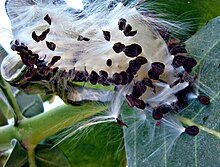| Calotropis procera | |
|---|---|

| |
| Scientific classification | |
| Kingdom: | Plantae |
| Clade: | Tracheophytes |
| Clade: | Angiosperms |
| Clade: | Eudicots |
| Clade: | Asterids |
| Order: | Gentianales |
| Family: | Apocynaceae |
| Genus: | Calotropis |
| Species: | C. procera
|
| Binomial name | |
| Calotropis procera | |
| Synonyms[2] | |
|
Asclepias procera Aiton | |


Calotropis procera is a species of flowering plant in the family Apocynaceae that is native to Northern and Tropical Africa, Western Asia, South Asia and Indochina (mainland Southeast Asia). It typically reaches a height between 6 feet (1.8 m) to 8 feet (2.4 m), and rarely to as high as 15 feet (4.6 m), and grows in sunny to partly-shaded habitats such as disturbed and overgrazed lands, rangeland, roadsides, river flats and coastal dunes.[3] Its green fruits contain a toxic milky sap that is extremely bitter and turns into a latex-like substance, which is resistant to soap.
Common names for the plant include Apple of Sodom,[2] Sodom apple, roostertree,[3] king's crown,[4] small crownflower,[3] giant milkweed,[5] rubber bush,[2] and rubber tree.[2] The names "Apple of Sodom" and "Dead Sea Apple" stem from the ancient authors Josephus and Tacitus, who described the plant growing in the area of biblical Sodom.[6] Although not native to the New World, the plant (and other related milkweed species) has been cultivated, and feeds monarch butterfly caterpillars, in places such as California, Hawaii and the island of Puerto Rico.[3][5] In Arabic, it is known as al-ashkhar.[7]
- ^ Harvey Brown, Y (2022). "Calotropis procera". IUCN Red List of Threatened Species. 2022: e.T19181123A212816097. doi:10.2305/IUCN.UK.2022-2.RLTS.T19181123A212816097.en. Retrieved 17 December 2022.
- ^ a b c d "Calotropis procera". Germplasm Resources Information Network. Agricultural Research Service, United States Department of Agriculture. Retrieved 2010-06-26.
- ^ a b c d "Calotropis procera". Plant Finder. St. Louis: Missouri Botanical Garden. Archived from the original on November 26, 2022. Retrieved February 3, 2024.
- ^ "Australian Plant Names Index". Retrieved 3 September 2014.
- ^ a b "Not All Monarchs Migrate! The Puerto Rican Subspecies Stays Put" (PDF). United States Department of Agriculture: Natural Resources Conservation Service. June 23, 2016. Archived (PDF) from the original on June 8, 2023. Retrieved February 2, 2024.
The Puerto Rican monarch's primary host plants are red milkweed (Asclepias curassavica), which is native to North and South America, and giant milkweed (Calotropis procera), which is native to Europe.
- ^ The Jewish Encyclopedia: Apple of Sodom
- ^ "Campers warned to avoid plants in UAE that can lead to coma, corneal damage". gulfnews.com. 2019-03-21. Retrieved 2024-04-24.
